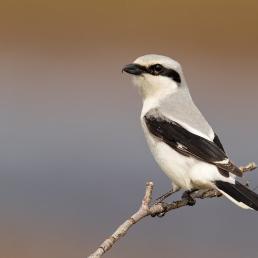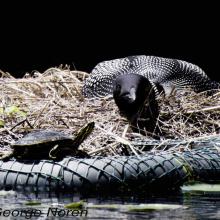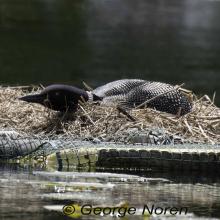

Join BirdNote tomorrow, November 30th!
Illustrator David Sibley and actor H. Jon Benjamin will face off in the bird illustration battle of the century during BirdNote's Year-end Celebration and Auction!
Loons are built for life in the water – so much so that their legs don’t work well on land. During migration, loons sometimes mistake wet pavement for the reflective surface of deep water and try to land there, then become unable to take flight again. If you see a stranded loon on a road or parking lot, calling a wildlife rehabilitator can help start the process of returning that bird to safety and back on their migratory journey.
BirdNote®
Recognizing a Stranded Loon
Written by Conor Gearin
This is BirdNote.
[Minnesota lake soundscape]
[Loon call]
Loons are built for life in the water. They’re streamlined and dense to pursue fish deep below the surface. Loons’ legs are placed far back on their bodies, almost like propellers, a unique advantage for life on the lake — but those legs don’t work well on land. That’s why if you see a loon on terra firma, something has probably gone wrong.
[Common Loon flight call]
During migration, loons sometimes mistake wet pavement for the reflective surface of deep water and try to land there. And once they touch the ground, they’re stuck. Loons can’t walk more than a short distance, and they’re so heavy that they need at least a hundred feet of water to launch into the air.
If you see a stranded loon on a road or parking lot, calling a wildlife rehabilitator can help start the process of returning that bird to safety and back on their migratory journey. Early spring is a good time to keep an eye out for them, when loons are on the move and the weather is wet.
By looking out for migrating loons, people can help ensure these submarine-like birds reach their northern breeding grounds safely.
[Common Loon wails]
For BirdNote, I’m Ariana Remmel.
[Common Loon wails]
Support for BirdNote is provided by Sarah Merner and Craig McKibben, and generous listeners around the world.
###
Producer: Mark Bramhill
Managing Editor: Jazzi Johnson
Managing Producer: Conor Gearin
Content Director: Jonese Franklin
With thanks to BirdNote science advisor Shailee Shah for this idea
Bird sounds provided by The Macaulay Library of Natural Sounds at the Cornell Lab of Ornithology, Ithaca, New York. Environmental ML527181 recorded by Wil Hershberger, Common Loon ML107964 recorded by Steven R. Pantle, Common Loon ML361635171 recorded by Daniel Jauvin, and Common Loon ML195281331 recorded by Maureen Chambrone.
BirdNote’s theme was composed and played by Nancy Rumbel and John Kessler.
© 2024 BirdNote April 2024
Narrator: Ariana Remmel
ID# COLO-05-2024-04-18 COLO-05







